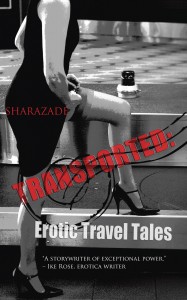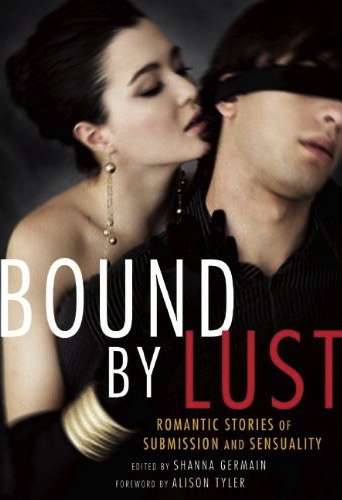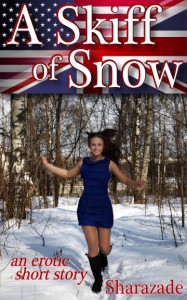It’s a little strange that I bought myself a copy of Best S & M III: Still More Stories of Still More Extreme Sex (published by Logical Lust, 2010), and that is because of its title. “Best” is fine, and “III” sounds good, but to be honest, S & M (sadism & masochism) really isn’t my thing. I have no objections to it, on either side, it just doesn’t hold any strong personal interest.
Just to be sure, I checked a dictionary. This definition is for the term sadomasochism, but you could divide it easily enough: The combination of sadism and masochism, in particular the deriving of pleasure, especially sexual gratification, from inflicting or submitting to physical or emotional abuse. Well, there you go. “Abuse” does not sound appealing to me.
So why buy a whole anthology of it? Well… it was a loaf I bought for one slice. For about a year, I’ve been following the blog of a writer called Oatmeal Girl. Her blog is largely personal reflections, with some poetry and a little fiction. And I just love her writing (even though, yes, she does write a lot about sadism, and masochism… but in a way I like, somehow….). She’d never published offline before, though. So when I saw an announcement on her blog that she had a story coming out in print, I wanted it!
Of course, the book arrived with more than just her story in it. I told myself that I’d review it if I liked 60% or more of the stories in it, and the fact that this post exists answers that question. Indeed, the whole collection was a delightful surprise.
It is of course not the editor’s fault that I hadn’t read books I and II in this series, so I really had no idea what to expect. I don’t need to embarrass myself by saying what I had expected, but what I found was a collection of stories that focus on psychological interactions between lovers, and it is fascinating. It isn’t “abuse” at all, not as I understand that word, anyway. And just some damn good writing.
The collection as a whole holds together well. While all of the stories have some aspect of power imbalance and control, it isn’t all “Mistress Ashley whips slave Derek” (in fact, none of it is). There are physical stories, and psychological stories, and realistic stories, and fantasies, and humorous stories, and dark stories, and stories I’d be hard-pressed to really classify. There’s one that’s all hot foreplay, leaving the actual sex to unfold after the story ends; and one barely refers to physical interaction at all.
I can’t review every story in the collection, and I can’t even review 60% of them, because the review would just go on forever. I’ve chosen therefore just a few. These were stories I especially liked, and also ones I felt I could say something about—because sometimes you can read a story and love it, but just have little to say other than “Wow.” Which does not make a fascinating review.
~ ~ ~
You Wake ahead of the Alarm (Oatmeal Girl)
The first line of the first paragraph, as printed, is
You wake ahead of the alarm, the sun knocking on your face
The second paragraph begins like this:
You wake ahead of the alarm, the sun knocking on your
Uh-oh! Did the editor or the printer screw up? That’s the same line! (the second paragraph gets one less word because it begins with an indent, which the first one doesn’t). I double-checked. No… it was deliberate, and each sentence finishes differently.
The third paragraph begins the same way, then repeats an element of the second one (but not the first), like the theme & variation of a fugue. Other words and phrases are similarly picked up and carried through for a bit. It’s enchanting, and it’s not something I’m used to seeing in English writing—although it is very much a characteristic of Arabic writing.
The other feature I liked in this piece was the voice—the narrator uses she (for the woman), but writes to you (a man). It’s tricky to use you (although it’s one of my favorite ways to write), because the reader (in all but one case, at most) isn’t the person in the writer’s head; but pitched just right, it can be very sexy. The she instead of I is even more unusual, and I love the effect. It makes the narrator so much more submissive, so objectified, and I think that little quirk in the writing style says as much about their relationship as what actually unfolds in the scene.
I realize I’ve now written 255 words about this story and not said what it’s about. Well, I guess you’ll just have to buy the anthology and read it. 😉
~ ~ ~
Halloween (Cecilia Tan)
Where I live, there’s a place where the goth kids hang out (and I know many are in their 20’s, but they still seem like “kids” to me). They dress outlandishly—huge spiked hair, dyed in lurid colors; black leather with zippers bustin’ out all over; faces that look like they’ve been attacked by a feral Ronco Rhinestone and Stud Setter (she said, revealing her age). They seem to be screaming for attention, yet they’ve always struck me as fundamentally shy, somehow. Certainly if I talk to them, they shrink back; and yes, I do talk to them sometimes. I’ve asked about hair styling (I’m just really interested in hair!), and I once asked one with the really low-slung pants how on earth they stayed up (he showed me—string! he had string suspenders that went under his t-shirt). I don’t find the goth style attractive, but I do admit to a fascination with that in-your-face/shy dichotomy.
The … OK, what do I call her? protagonist? heroine? female lead? none of those seem fitting. The … girl-that-the-story-is-about in Halloween is just like those kids, or at least as I imagine them. Tan captures that mix of bravado and insecurity, and it’s totally convincing. The girl is aggressive, and scared, and a bit of a jerk, and oddly sweet. It might seem strange to call a story that has more pages of graphic sex than anything else (2 pages of build-up, 12 pages of sex, if you’re counting) “sensitive,” but it is. Sensitive, and really hot.
~ ~ ~
Lucky (Xan West)
I enjoyed Halloween for its realism, and this one for just the opposite reason. This story describes the lengths a slave goes to during the course of an evening to feel owned by her mistress. I’m not a slave, or a lesbian, and I don’t enjoy humiliation. And yet… the story works for me. Again, it comes back to strong writing, and also to being able to articulate the feelings behind the actions. I don’t think there’s much in that story I would actually do, and yet the opening lines speak to me of me:
I need to be forced to name my desires. I need to look them in the eye and accept them for mine. I need to travel that long journey through shame into pride.
It takes a skilled writer to convince me of the reality of a life isn’t at all like mine, and she (he? I don’t even know) (or care) did it; and—trickier still—aroused me while doing so.
~ ~ ~
Empty Vessel (Shanna Germain)
I’ve tried three times now to write about this story, and I keep deleting it. When I try to describe it, it doesn’t come out right. Just read it.
~ ~ ~
Down Below (Jean Roberta)
This story came just at the right time for me, because I’d finished writing one of my own that includes a one-line reference to the novel 1984. And I wondered… but what if someone hasn’t read 1984? If I explain the line, I ruin it. I don’t want to take it out, because I like it. But do I risk losing some readers?
Here, for me, was Jean Roberta’s answer. A good part of the plot of Down Below refers to a short story by Edgar Allen Poe. The two main characters in the story work in a university’s English department, and they discuss the story.
Now, I have to say, I’ve read quite a few books set in university English departments (most of them murder mysteries, which must say something about university English departments), and the part where two characters discuss a book is a tricky one. Certainly professors do discuss books with each other, and they discuss plot and character and setting and symbolism and all that in great depth sometimes. But what they don’t do is summarize the book as if someone who hadn’t read it is eavesdropping in the hallway. They don’t say, for example, “Yes, but then in Chapter 2, Anne moves to Green Gables, situated on Prince Edward Island in Northeastern Canada, to live with Matthew and Marilla Cuthbert, the latter a curmudgeonly old lady beneath whose rough exterior beats a heart of gold.”
So Roberta’s characters talk about the story’s plot (which is relevant to the current story unfolding), but they don’t OVERtalk about it. And what I particularly liked is that they didn’t name it. Either you’ve read the story, in which case you don’t need to have it named here; or you haven’t, in which case you’re probably not going to throw aside your Best S & M III and rush out to the library to get it. (But if you haven’t read it and feel you simply must know, then you ought to read Poe’s Collected Works. You’ll find it here, and much more besides!).
Now, I did ask myself how the story would work if you had not read the Poe. It would work just fine. The Poe is an added a layer, a treat for someone who knows it, but the plot unfolds perfectly well without it. Very neatly done. (And I’m leaving in my 1984 line.)
~ ~ ~
Six of the eighteen stories in this collection have been published elsewhere; some may, in the future, be published elsewhere too. However, what makes this a book worth buying is not only the individual stories but how they work together. Eighteen variations on a theme, or eighteen interpretations of a dynamic I’d now be curious to read more about.
Best S & M III contains stories by these authors: Billierosie, M. Christian, Mykola Dementiuk, Shanna Germain, Ralph Greco, Jr., Theda Hudson, Kane, Jude Mason, Oatmeal Girl, Jean Roberta, Jerry Rosen, Jason Rubis, Craig J. Sorensen, Cecilia Tan, Jan Vander Laenen, Sharon Wachsler, Xan West, and PM White.
Buy the print or e-book from the publisher here, or on Amazon here.






